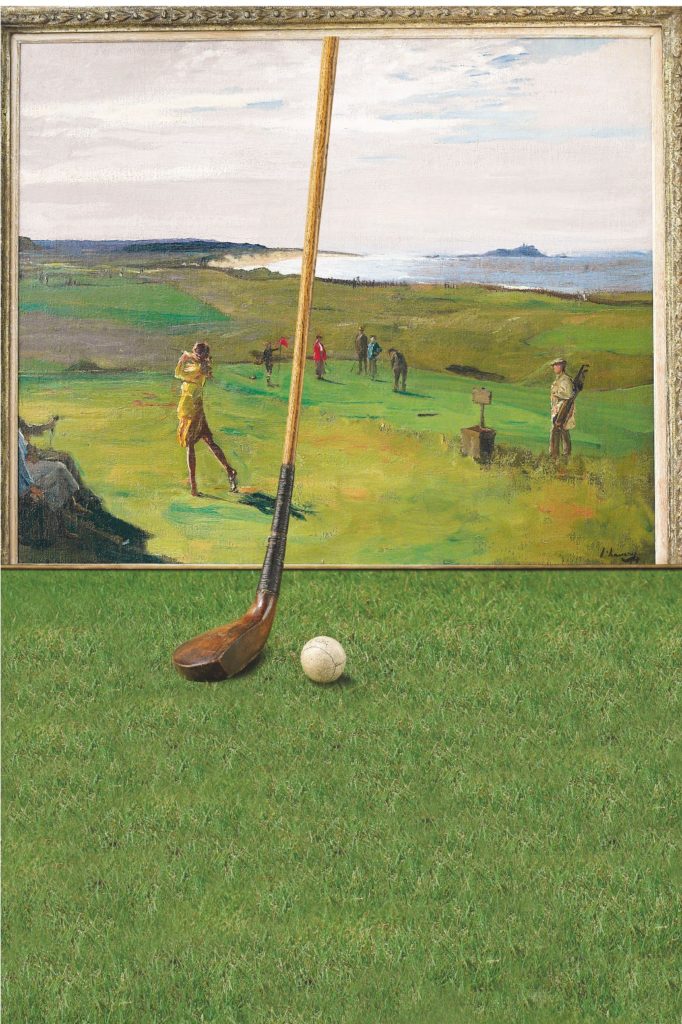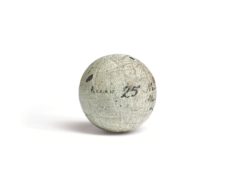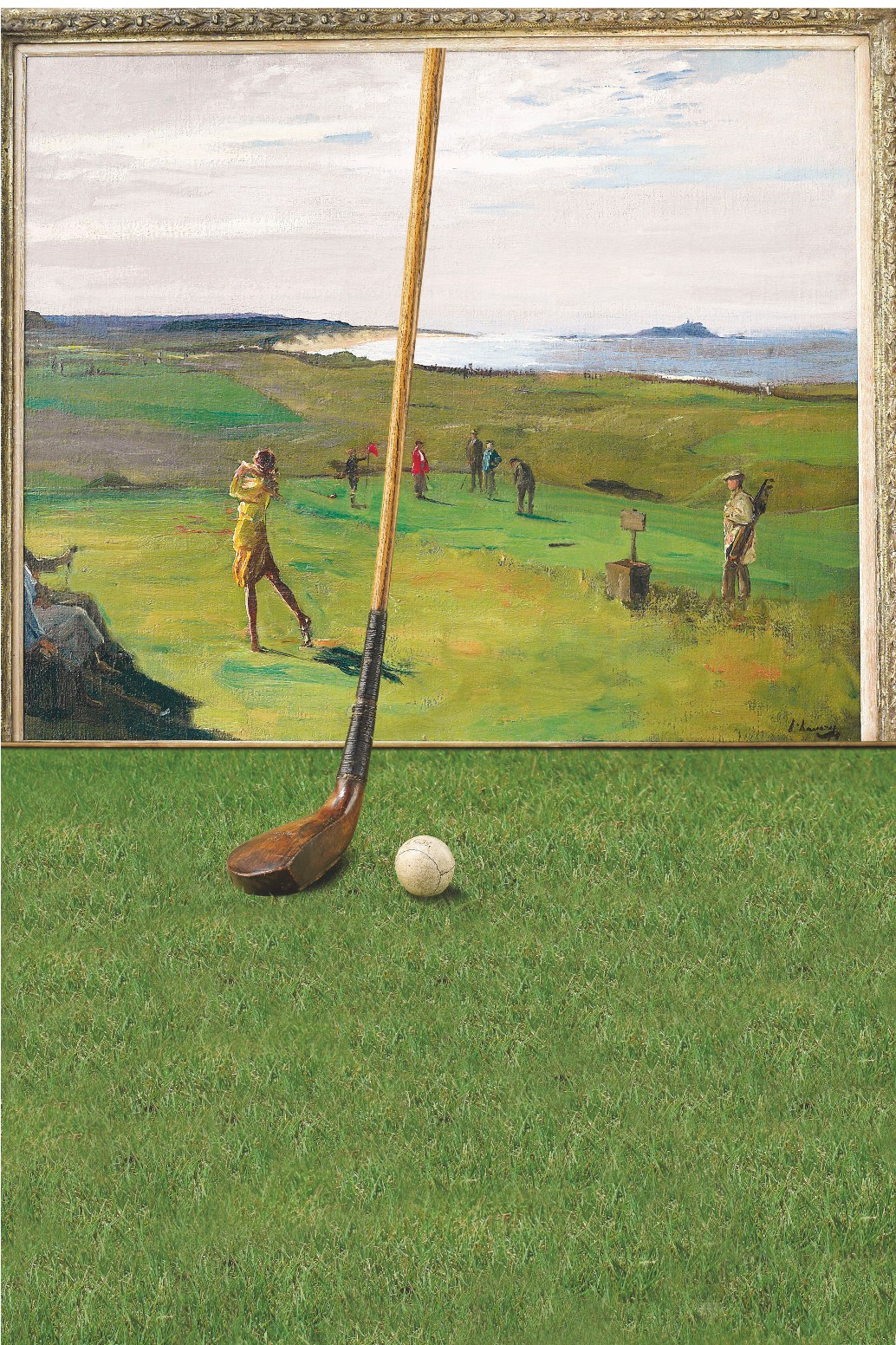 On 30 May 2012, Christie’s will auction the world’s most important private collection of golf art and memorabilia. Passionately assembled over 25 years by Jaime Ortiz-Patiño, the founder of the world-famous Valderrama Golf Club, this historic collection includes some of the rarest and most valuable treasures representing the history of the sport, and its most notable personalities, from its earliest references in the 15th century to a programme for the inaugural Masters Tournament in 1934. Presenting an unprecedented selection of historic clubs, balls, paintings, ceramics and books, the collection will offer approximately 400 lots and is expected to realise in excess of £2 million.
On 30 May 2012, Christie’s will auction the world’s most important private collection of golf art and memorabilia. Passionately assembled over 25 years by Jaime Ortiz-Patiño, the founder of the world-famous Valderrama Golf Club, this historic collection includes some of the rarest and most valuable treasures representing the history of the sport, and its most notable personalities, from its earliest references in the 15th century to a programme for the inaugural Masters Tournament in 1934. Presenting an unprecedented selection of historic clubs, balls, paintings, ceramics and books, the collection will offer approximately 400 lots and is expected to realise in excess of £2 million.
From its early origins in the East coast of Scotland, Golf is now one of the most popular sports in the world, and also one of the most lucrative; in 2011, the two highest earning sportsmen were Tiger Woods and Phil Mickelson. Now played all around the world, golf’s rich history has unfolded over many centuries in Scotland. This collection charts and celebrates the history and development of the game, and includes golf clubs and balls used by some of the true champions of the Golden Age, including Allan Robertson, Old Tom Morris, Young Tom Morris and Willie Park Snr. who, between them, won twelve Open Championships.
Art
 The collection includes the preparatory oil sketch for the most famous painting in the history of golf. The Golfers by Charles Lees, R.S.A. (1800-1880) is the preparatory oil study for the painting which is now in the Scottish National Portrait Gallery. The preparatory sketch measures 15½ x 24½ inches and represents a rare opportunity to acquire an original painted image which has since been copied the world over. It depicts a game in play during the October Meeting of 1847 at the Old Course, St. Andrew’s, between Sir David Baird and Sir Ralph Anstruther against Major Playfair and John Campbell Esq. of Glensaddle. It is expected to realise £120,000 to £180,000.
The collection includes the preparatory oil sketch for the most famous painting in the history of golf. The Golfers by Charles Lees, R.S.A. (1800-1880) is the preparatory oil study for the painting which is now in the Scottish National Portrait Gallery. The preparatory sketch measures 15½ x 24½ inches and represents a rare opportunity to acquire an original painted image which has since been copied the world over. It depicts a game in play during the October Meeting of 1847 at the Old Course, St. Andrew’s, between Sir David Baird and Sir Ralph Anstruther against Major Playfair and John Campbell Esq. of Glensaddle. It is expected to realise £120,000 to £180,000.
A portrait of John Whyte-Melville, who features in The Golfers, and who was referred to by the members of The Royal and Ancient as ‘the father of the club’, will also be offered at the sale (estimate: £80,000 to £120,000). Executed by Sir Francis Grant, P.R.A., a smaller version of the painting hangs in the Royal and Ancient clubhouse in St. Andrews. John Whyte-Melville is said to have played two rounds a day, three days a week until he was well over 85. He became a member of the Royal and Ancient in 1816 and was elected Captain in 1823. He played an instrumental role in the development of the Club and laid the foundation stone of the clubhouse.
The Golf Course, North Berwick by Sir John Lavery, R.S.A., R.H.A., R.A. (1856-1941) will be offered with an estimate of £200,000 to £300,000. This painting is from a series of works the artist painted at the Scottish golf course in 1921 and 1922, another example of which is at TateBritain having been presented by Lord Duveen. They are the most valuable and desirable modern depictions of the game.
Golf clubs
 A leading highlight is the Morris Putter, a club owned by two of history’s most celebrated golf champions (estimate: £40,000 to £70,000). Crafted by Hugh Philp, a master club-maker based at St. Andrews whose thorn, apple and pear wood putters were particularly revered, it was owned and used by Old Tom Morris and his son Young Tom Morris who between them won eight Open Championships – perhaps while using this club. A group of eight professionals played the first Open Championship at Prestwick in 1860, an event won by Willie Park Sr., who would go on to win the event three more times. Runner-up in 1860 was Tom Morris Sr., known as ‘Old Tom Morris’, who went on to win the event four times, and who still holds the record as the oldest winner of the competition (46 years old in 1867). It was Tom’s son, Tom Morris Jr., who was golf’s first prodigy.
A leading highlight is the Morris Putter, a club owned by two of history’s most celebrated golf champions (estimate: £40,000 to £70,000). Crafted by Hugh Philp, a master club-maker based at St. Andrews whose thorn, apple and pear wood putters were particularly revered, it was owned and used by Old Tom Morris and his son Young Tom Morris who between them won eight Open Championships – perhaps while using this club. A group of eight professionals played the first Open Championship at Prestwick in 1860, an event won by Willie Park Sr., who would go on to win the event three more times. Runner-up in 1860 was Tom Morris Sr., known as ‘Old Tom Morris’, who went on to win the event four times, and who still holds the record as the oldest winner of the competition (46 years old in 1867). It was Tom’s son, Tom Morris Jr., who was golf’s first prodigy.
While his father was Open Champion, ‘Young Tom Morris’, when he was only 13, defeated him for the first time. He is the only player to have won the Open four times in a row and he still holds the record as the youngest ever winner of a major championship (17 years old in 1868). By the time he won the competition for the fourth time he was only 21 years old. He set a record score of 77 at The Old Course in St. Andrew’s that would stand for twenty years and in 1868 he scored the first ever tournament hole in one. He pioneered backspin, shaping shots and chipping, and his exhibition matches would draw crowds of thousands, including golf correspondents sent from London. Tragically he died aged 24 on Christmas Day in 1875, having already achieved so much, and having elevated the game to new heights.
The early game was played using feather-filled golf balls and, in the main, bespoke wooden-headed golf clubs. Iron-headed clubs were extremely rare. A leading highlight in the golf club section is one of the rarest and most valuable early golf clubs in private hands. The square toe iron from the late 17th or early 18th century is an exceptionally rare early example of an early square-toe iron. Comparable to the two irons in the Royal Clubs of Troon – the oldest set of golf clubs in existence, which is currently on view at the British Golf Museum in St Andrews, the present club is believed to be one of only twenty recorded to exist. It is expected to realise £80,000 to £120,000.
An even earlier iron club is the Wemyss spur-toe light iron, a 17th century club formerly owned by James, the 5th Earl of Wemyss (1699-1756), a founding member of St. Andrews. Considered to be the earliest of iron golf clubs, the spur-toe was used for hitting out of the rough and evolved into the square-toe in the 18th century (estimate: £60,000 to £100,000). An 18th century long-nosed scared head putter believed to have been made by Andrew Dickson, a famed golf club maker from a family who are recorded to have been making clubs as early as 1629, is expected to realise £60,000 to £100,000. This club was exhibited at the Glasgow International Exhibition in 1901 which celebrated the oldest and greatest objects of Scottish history. The Royal Perth Putter from the late 17th or early 18th century is expected to realize £70,000 to £100,000. This is extremely rare as an early metal-headed putter, as opposed to a conventional wooden putter, and was previously in the collection of The Royal Perth Golfing Society, which was the first society to be granted Royal patronage by King William IV in 1833. Also from the same historical collection is a square-toe light iron from the 18th century (estimate: £50,000 to £70,000).
An extremely rare and early club made by James McEwan circa 1786 is expected to realise £40,000 to £60,000. The McEwan name was synonymous with golf equipment of the finest quality in the 18th and 19th centuries. Founded by James McEwan, the business was based at Bruntsfield Links, original home of The Royal Burgess Golfing Society ofEdinburgh. By the turn of the 19th century, they were supplying the other golfing centres of Aberdeen, Montrose, St. Andrews, Perth and Blackheath. The present club is one of only three made by James McEwan known to exist, and was exhibited at the Glasgow International Exhibition in 1901 where it was described as ‘amongst the rarest golf items displayed.’
Golf balls
 The early game involved hitting a wooden ball with a wooden stick, but the game was revolutionised in the early 17th century with the introduction of the ‘Featherie’ golf ball. These were often more expensive than a golf club and are thought to have contributed to the notion of golf as a rich man’s sport. A player would use the same ball for up to 6 months or more. A wet cowhide sphere was stuffed with a top-hat fill of wet goose feathers. As the cowhide dried, it shrank and as the feathers dried, they expanded, thus creating a hard, compact ball. The auction will offer a comprehensive range of Featherie golf balls, with estimates ranging from £5,000 to £20,000.
The early game involved hitting a wooden ball with a wooden stick, but the game was revolutionised in the early 17th century with the introduction of the ‘Featherie’ golf ball. These were often more expensive than a golf club and are thought to have contributed to the notion of golf as a rich man’s sport. A player would use the same ball for up to 6 months or more. A wet cowhide sphere was stuffed with a top-hat fill of wet goose feathers. As the cowhide dried, it shrank and as the feathers dried, they expanded, thus creating a hard, compact ball. The auction will offer a comprehensive range of Featherie golf balls, with estimates ranging from £5,000 to £20,000.
In the mid-19th century, the Featherie was replaced with the gutta percha ball, or the gutty ball. Gutta-percha is the evaporated latex produced from a rubber tree most commonly found in Malaysia. The new durability of the Gutta, together with its much lower cost, resistance to water, and improved run, provided rejuvenation to the game of golf, but not without some resistance. Allan Robertson, the greatest player of his age, was said to have initially burned gutty balls when they first appeared, and also dismissed his apprentice, Old Tom Morris, after he used the new type of ball in a tournament.
Robertson was later to embrace this new type of ball and the auction includes a great and fascinating rarity; an early Gutty ball made by Allan Robertson which is inscribed ‘a new kind of golf ball made of gutta-percha in the year 1849’ (estimate: £12,000 to £18,000). In 1858, Robertson became the first player to score under 80 on the Old Course – a feat he achieved using a Gutty ball. His death the following year prompted the golfers at Prestwick to host a competition to determine who was now the best golfer. This tournament was the first Open which is now celebrated as the oldest major golf competition in the world.
Chinese Export Porcelain
A Chinese export porcelain punch bowl from the late 18th century, painted with a depiction of a golfer, is an exceptionally rare depiction of the game of golf on Chinese porcelain. The depiction of the golfer is taken from a drawing by David Allan which formed part of the letterhead of the Honorable Company of Edinburgh Golfers, and it is thought that this bowl may have been commissioned by them, or by the Chisholm Family whose arms are also depicted on the reverse. It is expected to realise £40,000 to £60,000.
The origins and development of Golf
The origins of golf are subject to frequent discussion and sometimes dispute. A number of early games which used a ball and a club are referenced in history including Jeu de Mail, an Italian game where a player had to loft a ball through various hoops, and Kolf which was played in Holland and which used heavy clubs and larger balls than we know today.
There is no dispute that Golf was played on the East coast of Scotland in the 15th century where the public land beside the sea was used by anyone with a club and ball. The looming threat of English invasion in 1457 saw King James II declare a Scottish Act of Parliament discouraging the playing of ‘gouff’ as it was interfering with archery practice; there are records of King James IV having bought clubs and balls from a bowmaker in Perth in 1502; and Mary Queen of Scots was famously reproached for playing golf in the grounds of Seton House so soon after the death of her husband, Lord Darnley, in 1567. According to tradition, Scottish exiles played golf at Blackheath, outside London, in 1608 when James VI of Scotland ascended to the English throne.
The first official rules of golf were written in 1744 by the Company of Gentlemen Golfers, later renamed The Honourable Company of Edinburgh Golfers, who now play at Muirfield in East Lothian. In 1800 there were only seven golf clubs or golfing societies recorded. By 1850 that figure had grown to seventeen. It was not until the second half of the 19th century that Golf developed into the modern format that we know today. The Founding Fathers of the modern game included Allan Robertson, the Park family, the Morris family and Hugh Philp. Many of the earliest pioneers were course professionals who made clubs and balls, tended the course and would play for money in exhibition matches that became a popular spectator sport.
The first Open Championship was played at Prestwick in 1860. The following decades saw interest in the sport grow internationally and exponentially. In 1864, Westward Ho! became only the second golf course inEngland. By 1880, golf courses could be found in Ireland, Australia, New Zealand ,Canada and South Africa. By 1910, there were over 250 golf clubs in the USA, and nearly 1,000 in England. Today, there are estimated to be over 30,000 golf courses in the world, with over 50 million people playing the Royal and Ancient game.
Christie’s www.christies.com


